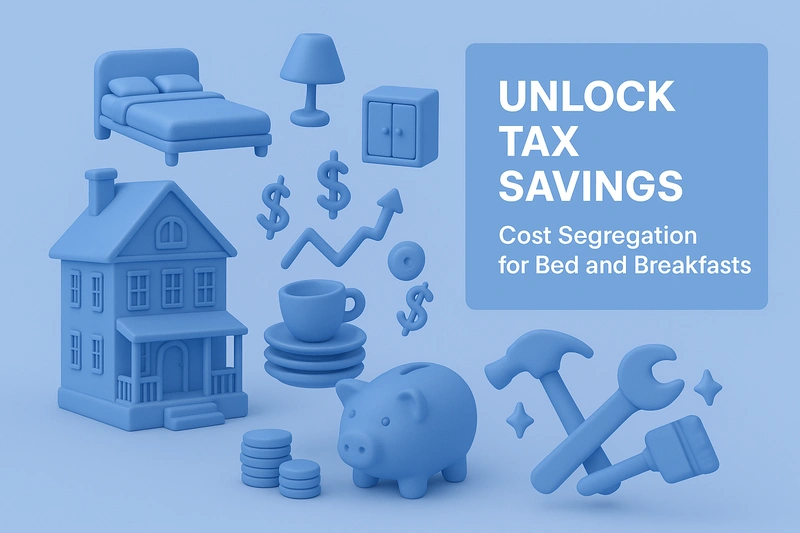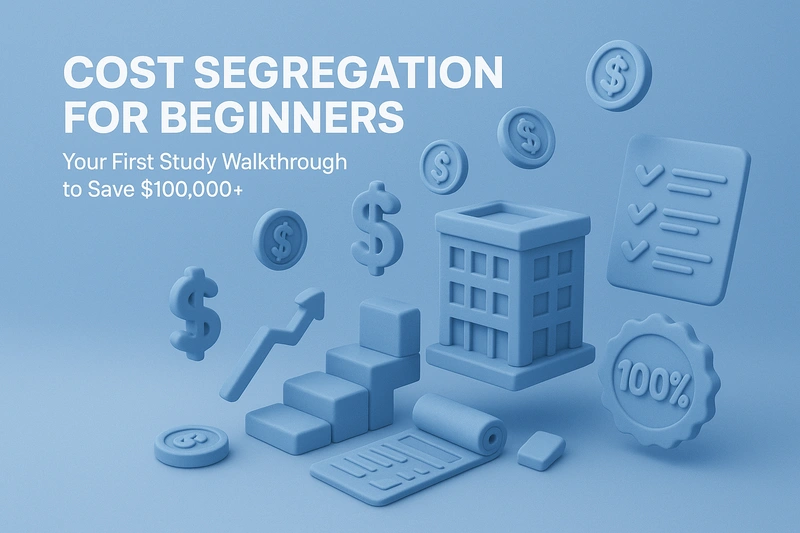I once worked with a couple who had turned their historic home into a charming bed and breakfast. They were proud of how quickly bookings filled up during peak season, but frustrated with how much of their revenue disappeared into taxes.
Like many B&B owners, they assumed depreciation was a slow, fixed process, something you just “accept” as a property owner. It wasn’t until we ran a cost segregation study that they realized their building wasn’t just a home with guest rooms; it was an investment property with layers of tax-saving potential.
Within the first year of applying the study, their cash flow improved enough to renovate two additional suites.
That experience reminded me of a common theme: bed and breakfast owners often underestimate how much the IRS allows them to accelerate deductions. Understanding cost segregation can mean the difference between just running a property and strategically growing one.
What Cost Segregation Really Means for Bed and Breakfasts
Cost segregation is the process of breaking down a property into individual components (like flooring, lighting, cabinetry, or even landscaping) that can be depreciated faster than the standard 27.5- or 39-year timeline applied to residential or commercial property.
For bed and breakfasts, this distinction is especially valuable. Unlike a traditional rental property, a B&B is designed for frequent turnover and elevated guest expectations. Owners invest heavily in guest-facing amenities, many of which qualify for accelerated depreciation:
- Flooring and finishes: Carpets, hardwood, or decorative tile that wears down quickly with guest use
- Cabinetry and built-ins: Custom storage or breakfast bars are often installed for guest convenience
- Lighting and electrical: Accent lighting, chandeliers, or upgraded electrical systems for common areas
- Specialized kitchens and appliances: Equipment for daily meal service that differs from typical residential use
- Outdoor improvements: Decks, patios, walkways, and landscaping designed to enhance curb appeal
Take the couple I mentioned earlier who converted their historic home into a B&B. Their original tax treatment lumped everything into a 27.5-year residential schedule.
But once we conducted a cost segregation study, we were able to reclassify the extensive cabinetry they installed in the dining room for serving breakfast into a 5-year schedule. This represented thousands of dollars in deductions they could take much sooner.
What had felt like “just decor” or “basic furnishing” to them actually qualified as short-life property under IRS guidelines. That’s the core of cost segregation for B&Bs, recognizing that the very details that make a property attractive to guests are also the details that accelerate tax savings.
The Unique Tax Position of Bed and Breakfast Properties
Bed and breakfasts sit in a gray area of the tax code. A long-term rental is typically treated as residential property, while hotels are treated as commercial. A B&B, however, has traits of both: private bedrooms and living areas like a residence, but revenue-generating guest spaces like a hotel.
This hybrid status often leads owners to default to a conservative approach, depreciating the entire property over 27.5 years. The problem is that this oversimplification ignores how much of the property is really serving a commercial purpose.
A cost segregation study brings clarity by:
- Distinguishing which parts of the property function like a residence versus those that operate like hospitality assets.
- Ensuring shared-use areas and guest amenities are properly categorized under shorter depreciation lives.
- Preventing owners from under-claiming deductions simply because their property doesn’t fit neatly into one tax category.
This isn’t just about accelerating depreciation; it’s about recognizing that bed and breakfasts are fundamentally different from both houses and hotels. Cost segregation addresses that complexity head-on, turning a potential compliance gray area into a financial advantage.
How Bonus Depreciation Amplifies the Benefits
One of the most powerful tax tools available to bed and breakfast owners is bonus depreciation. This provision allows qualifying assets with a useful life of 20 years or less, like furniture, appliances, cabinetry, or landscaping, to be written off entirely in the year they’re placed in service.
When paired with cost segregation, bonus depreciation can be a game-changer. A study identifies which components of your property fall into shorter asset lives, and bonus depreciation then allows you to deduct the full value of those assets immediately.
For example, if a B&B upgrades its guest bathrooms and kitchen with $150,000 worth of improvements, a standard schedule might spread those deductions over 15 years. With cost segregation plus bonus depreciation, most of that cost could be deducted in the first year, dramatically reducing taxable income right away.
This is particularly valuable for bed and breakfasts because income can be seasonal. Capturing large deductions upfront creates a financial cushion that helps smooth cash flow during slower booking periods.
And thanks to recent changes in tax law, bonus depreciation is now permanently set at 100% for most qualifying assets acquired after January 19, 2025. Well-planned renovations or upgrades could unlock full first-year write-offs that weren’t available just a year ago.
Common Misconceptions Owners Have About Cost Segregation
When I speak with B&B owners, I hear a few myths repeated often:
- “My property isn’t big enough.” Even smaller inns with fewer than 10 rooms can benefit, as long as the purchase or renovation costs justify the analysis.
- “It’s only for new builds.” Existing properties, especially those recently acquired or renovated, are just as viable.
- “It’s too aggressive.” When done properly, cost segregation is fully compliant with IRS guidelines and supported by detailed engineering-based studies.
The truth is, most B&B owners leave money on the table simply because they assume this strategy is reserved for large hotels.
When a Cost Segregation Study Makes the Most Sense
Timing matters. Cost segregation is most effective when:
- A property is newly purchased – the depreciation clock resets.
- Major renovations are completed – new assets can be categorized individually.
- Owners need to offset higher income years – accelerated deductions can match taxable events, like unusually strong booking seasons.
For B&Bs planning expansions or transitioning ownership, aligning a cost segregation study with these milestones can maximize benefits.
Turning Tax Savings Into Growth
Running a bed and breakfast requires a blend of hospitality and financial discipline. Margins can be thin, and seasonal swings put pressure on cash flow. Cost segregation gives owners a way to reclaim capital tied up in depreciation schedules and redeploy it where it matters most (guest experience, property upgrades, and long-term profitability).
If you operate a B&B and want to explore how cost segregation for bed and breakfasts can unlock hidden savings, partnering with an experienced firm is key. R.E. Cost Seg specializes in identifying opportunities that traditional accounting often overlooks, helping owners like you maximize tax savings and reinvest strategically in their properties.






